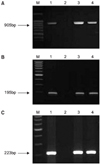Abstract
Brucellosis is a zoonosis, which is caused by Brucella abortus, B. melitensis, B. suis and B. canis. Brucellosis has been an emerging disease since the discovery of B. melitensis, by Bruce, in 1887. Worldwide, brucellosis remains a major source of disease in both humans and domesticated animals. A high prevalence in certain geographical areas is well recognized, but has been largely underestimated. In Korea, the first human case of Brucellosis occurred in 2002, but the incidence of human brucellosis has now increased. Herein, a case of epididymorchitis due to brucellosis is reported.
Figures and Tables
 | Fig. 1Detection of the polymerase chain reaction (PCR) products of Brucella genes. (A) 16S rRNA (905bp), (B) OMP 36kDa (195bp), (C) BCSP 31kDa (223bp) genes PCR products. Lane M: 1,000bp marker, lane 1: B. abortus, lane 2: normal control, lane 3: patient at initial test, lane 4: patient after 3 months. |
References
1. Korea centers for disease control and prevention. 2005 Communicable disease surveillance year book. 2005. 62.
2. Park MY, Lee CS, Choi YS, Park SJ, Lee JS, Lee HB. A sporadic outbreak of human brucellosis in Korea. Korean J Med Sci. 2005. 20:941–946.
3. De Massis F, Di Girolamo A, Petrini A, Pizzigallo E, Giovannini A. Correlation between animal and human brucellosis in Italy during the period 1997-2002. Clin Microbiol Infect. 2005. 11:632–636.
4. Young EJ. Mandell GL, Douglas RG, Bennett JE, Dolin R, editors. Brucella species. Mandell, Douglas and Bennett's principles and practice of infectious diseases. 2005. 6th ed. Philadelphia: Churchill Livingstone;2669–2674.
5. Kadikoylu G, Tuncer G, Bolaman Z, Sina M. Brucellar orchitis in Innerwest Anatolia Region of Turkey. A report of 12 cases. Urol Int. 2002. 69:33–35.
6. Navarro-Martinez A, Solera J, Corredoira J, Beato JL, Martinez-Alfaro E, Atienzar M, et al. Epididymoorchitis due to Brucella mellitensis: a retrospective study of 59 patients. Clin Infect Dis. 2001. 33:2017–2022.
7. Khan MS, Humayoon MS, Al Manee MS. Epididymo-orchitis and brucellosis. BJU Int. 1989. 63:87–89.
8. Osegbe DN. Testicular function after unilateral bacterial epididymo-orchitis. Eur Urol. 1991. 19:204–208.
9. Ingerslev HJ, Walter S, Andersen JT, Brandenhoff P, Eldrup J, Geerdsen JP, et al. A prospective study of antisperm antibody development in acute epididymitis. J Urol. 1986. 136:162–164.
10. Memish ZA, Venkatesh S. Brucellar epididymo-orchitis in Saudi Arabia: a retrospective study of 26 cases and review of the literature. BJU Int. 2001. 88:72–76.




 PDF
PDF ePub
ePub Citation
Citation Print
Print



 XML Download
XML Download